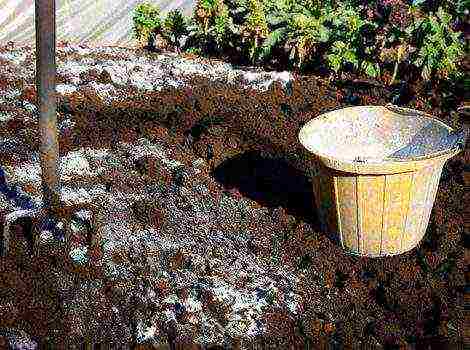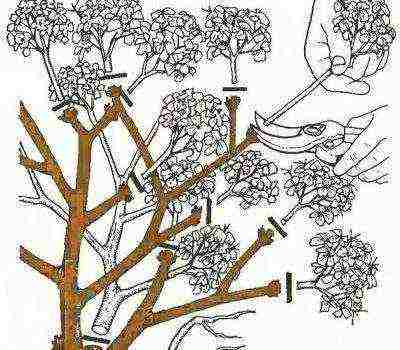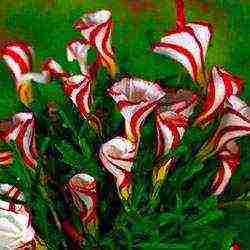Content
Sage, aka salvia, is another excellent representative of ornamental and medicinal plants. It belongs to the glorious genus of the lacustrine, which has given rise to many beautiful and useful flowers. I love its beautiful, narrow foliage and blue flowers. After articles by one author about sage, I wanted to learn as much as possible about such a familiar and beautiful plant for many. It turned out that the shapes and colors of sage are different: from the usual to the most outlandish and extraordinary. There are 700 different sage species in the world.

Sage is a perennial, but there are both annual and biennial species. Sage inflorescences are collected in panicles or spikelets. Stems are erect, can branch and reach a length of 120 cm.
Sage is an excellent helper in cooking and medicine. In ancient Rome, it was used in the treatment of many diseases, today it is just as relevant.
Planting sage
Most species of salvia officinalis like soils of normal acidity (5.5-6.5 pH). Plant the sage in a well-lit area. It will grow better on light, fertile soils. Loamy soils are well suited for this.
To enrich the soil before planting sage, humus or compost, as well as phosphorus-potassium fertilizers, are introduced in the fall for digging. At the onset of spring, the soil is leveled and broken with a rake, after which nitrogen fertilizers are also introduced.
Sage has been growing in its place for over 8 years. This culture grows well, so the seedling method can not be used, but sow seeds directly into the ground in early spring (March - early April, using film) or in the fall under the snow. It does not matter if you are delayed with planting, you can sow in May, then a film shelter for seedlings is not needed. At the same time, stratification and any other measures for germinating seeds are not required. You can arrange a ridge for sage, make a groove and seal the seeds to a depth of no more than 2 cm.Sage grows as a bush, so it is better to leave about 30 cm between the plants, and take about 50 cm between the rows.
It is not worth sowing sage after relatives from the lamb family. The precursors of sage can be potatoes, cabbage, onions, legumes.
Sage care
Pruning. In the second year after planting, like many spicy herbs with dense inflorescences, sage is renewed by cutting (10 cm from the soil surface).
Watering. Sage tolerates drought well, but it needs moisture to keep the greens juicy and tender. Otherwise, the leaves will simply become very tough. But it is not worth pouring, he does not like this.
Fertilization. In the spring before flowering, fertilizing with nitrogen mineral fertilizers is carried out, in the fall, after the plant is cut off and prepares for winter, many gardeners carry out fertilizing with phosphorus-potassium fertilizers in accordance with the norms on the package.
Sage picking
It is customary to use and harvest sage during its flowering period. The leaves can be eaten fresh, or they can be harvested for the winter, in bunches or spread out in a dark, warm, ventilated place (in the attic).
Sage species
After the studies carried out by the Novosibirsk Research Station, 12 species resistant to steppe conditions were selected. But they turned out to be so different in their characteristics that they were divided into three groups:
1. Plants of American origin were identified in this group, their habitual environment is subtropics. In their natural environment, such plants live for several years. In the middle lane in winter, the plant dies, therefore it is cultivated as an annual. At least 100 days will pass from germination to flowering.Therefore, the sage of this group is grown mainly by seedlings.
2. This group already includes varieties of Mediterranean sage. In their natural environment, they are perennial, but in our middle lane in the open field they will die in winter, so they have to be grown as annual plants. But it will take about 40 days from germination to flowering. This suggests that you can do without seedlings.
3. The most popular group with us. This group includes sage varieties that winter well in our open field. They are perennials in the temperate zone. This group also includes the Ethiopian sage, which is cultivated as a biennial. The most unaffected studies are Muscat, Marsh and Lavender Salvia.
I would also like to share with the reader photographs of different types of sage.
Salvia sticky
Salvia viridis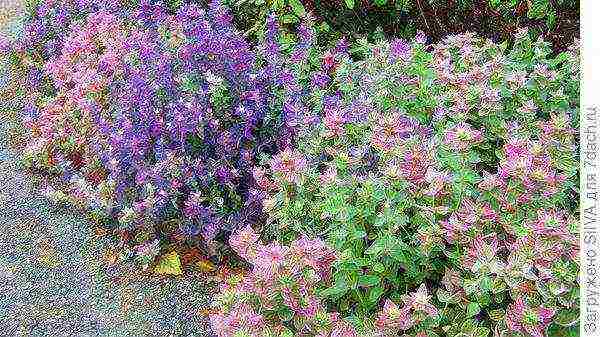
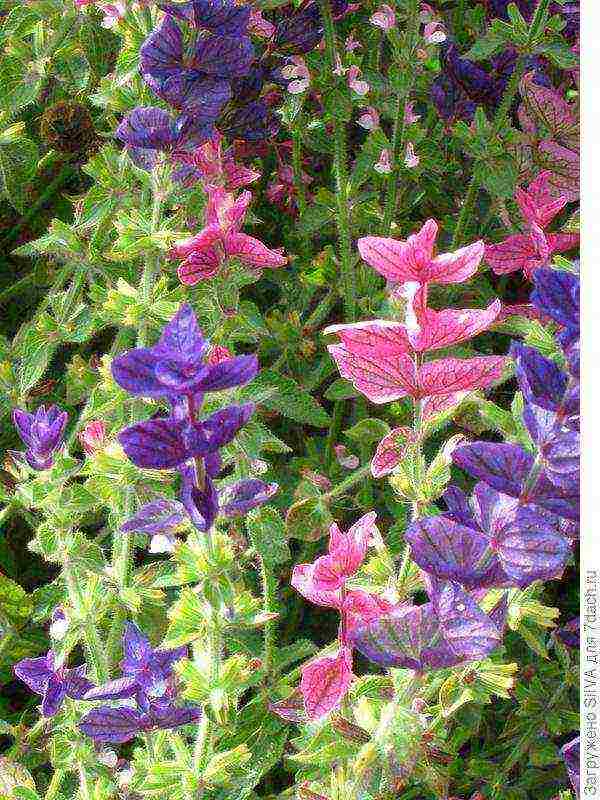
Salvia microphylla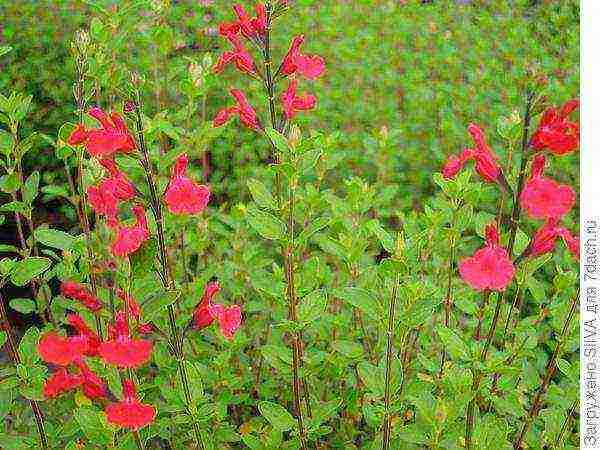
Salvia dolomitica
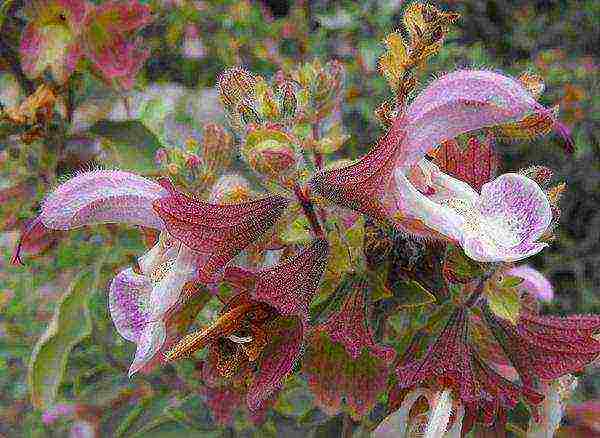
Sage varieties
Since this article mostly dealt with medicinal sage (vegetable), we will consider varieties that are suitable for different climatic zones and have excellent taste and irreplaceable medicinal properties.
Sage Breeze This variety is included in the State Register of the Russian Federation, it is recommended for consumption fresh and dried (young shoots and foliage), it is used for the preparation of desserts, salads, soups, sauces, meat, fish. Plants of this variety reach about 60 cm in height, with erect shoots and dense foliage. The leaves are pubescent, dentate at the edges. In the second year after planting, the bush of the variety reaches about 280 g. Flowers are violet-blue in color. Seeds are small, brown-black in color.
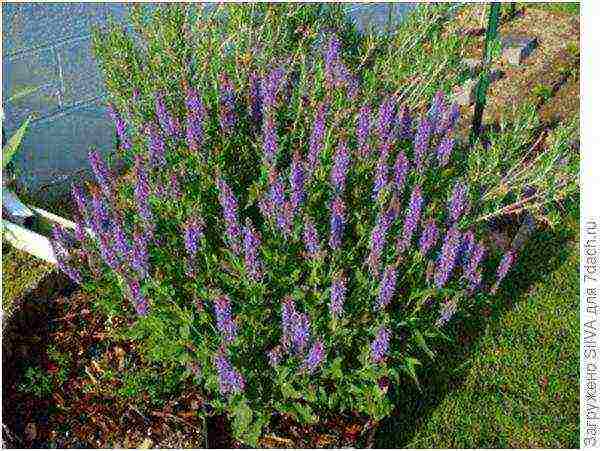
Sage Aibolit Like the previous variety, it is included in the State Register of the Russian Federation. It is consumed both fresh and dry. The plant is larger than the previous one, 60-120 cm tall. The leaf is dark green, finely toothed along the edge, wrinkled, has strong pubescence. It is customary to use the variety in the second year after planting, after a month from the beginning of the growing season. But it is not as persistent in winter as the previous variety, so in the middle lane it is better to cover it for the winter.

Sage Nectar The variety, included in the State Register of the Russian Federation, is very popular when combined with cheese and in aromatic culinary compositions. Its height is about 100 cm, the stem is erect. Foliage color is light green with pubescence. The flowers are blue-violet.
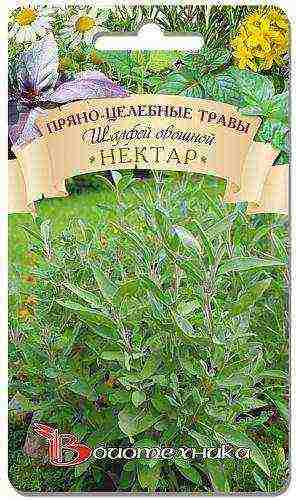
Sage Patriarch Semko The variety is used dry and fresh; it has been included in the State Register since 2000. The height of this variety is 50-80 cm. Erect, stiff stems at the bottom. Dense foliage up to 10 cm long. At the top of the shoot, the leaves are smaller. The seeds are in the form of a ball, the flowers are blue-violet.
I also recommend another author's excellent article on this wonderful plant.
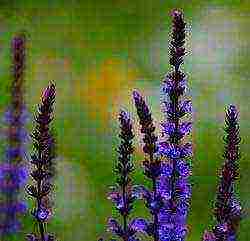 A variety of perennial sage varieties are used in landscaping to create amazing compositions. Planting, caring for and propagating these plants is straightforward. However, there are some peculiarities of growing them outdoors.
A variety of perennial sage varieties are used in landscaping to create amazing compositions. Planting, caring for and propagating these plants is straightforward. However, there are some peculiarities of growing them outdoors.
Varieties and varieties
The Latin name of the plant "Salvia" in the Russian interpretation means "to be healthy." Photo culture is often the hallmark of pharmaceuticals. It is a perennial herb, a shrub. Stems are tetrahedral, erect, reaching a height of up to 1.2 m. Shoots are densely covered with wedge-shaped leaves 4 to 8 cm long and 1 to 3 cm wide. The shape of the inflorescence is a spikelet or panicle. Small bright flowers bloom in mid-July and bloom until late autumn.

Sage is not only a beautiful but also a very useful plant.
The most common types are:
Salvia officinalis (S.officinalis) is a plant reaching a height of 20-70 cm. The leaves are elongated, narrow (0.8-1.5 cm), densely pubescent, gray-green in color, the stem is covered with whitish villi. It is widely used in cooking, medicine and cosmetology. Varieties:
- Breeze is a semi-shrub up to 60 cm high with jagged leaves and blue-blue flowers;
- Aibolit is a tall plant (up to 120 cm), distinguished by wrinkled dark green foliage with a strong edge;
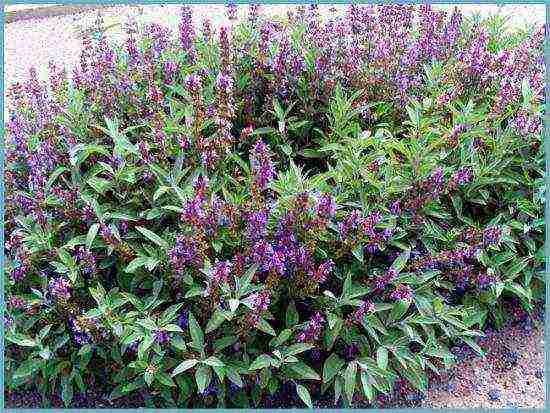
Salvia officinalis
- Nectar is a medium-sized bush, reaching 1 m in height. Leaves are light green, strongly pubescent. Spike inflorescences are strewn with purple or blue flowers;
- Semko Patriarshy is a low plant (50-70 cm) with long (up to 10 cm) leaves that densely cover the stalk stiff from below.
Forest sage (oak, wild - S. nemorosa) is a spice plant found on the edges of forests and on hillsides in the Mediterranean countries. The stem is herbaceous, the leaves are narrow, lanceolate. The flowers are collected in spike-shaped inflorescences of the violet or blue spectrum. Varieties:
- undersized - Plumosa, Blue and Pink Queen, Marcus - reach a height of 25 to 50 cm, bloom with pink, purple, blue and purple flowers;
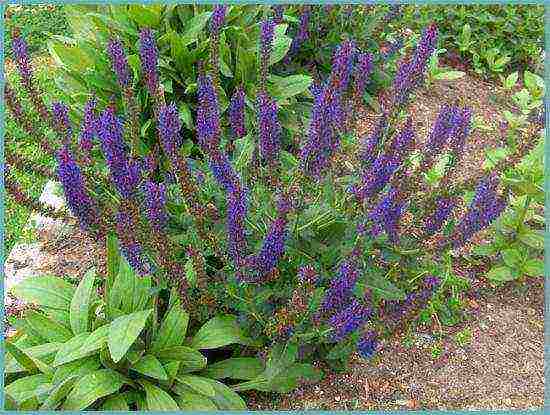
Forest sage
- tall - Adrian, Caradonna, Mainacht, Ametist - peduncles reach a height of up to 90 cm, dense spike-shaped inflorescences convey a wide range of colors - from white-pink delicate shades to deep violet-blue.
Meadow sage (S.pratensis) and Clary sage (S.glutinosa) is a species of oak sage. Sh. Sticky deserves attention because of the unusual greenish-yellow color of the leaves. Interesting photos, where lush paniculate inflorescences of a pale yellow color create a delicate background for brighter flowers.
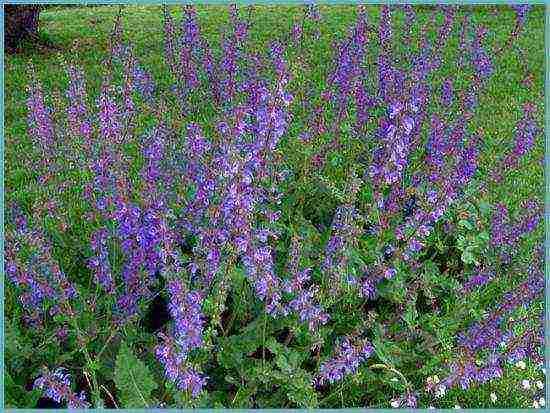
Meadow sage
Planting a plant
Different types of sage are ambiguous about equal conditions. Oak and meadow prefer sunny areas and moderate watering. These are drought-resistant plants for which waterlogging is dangerous. Clary sage naturally lives on the edges of the forest, so light shade and moist soil are of the highest priority for it.
Despite the differences, there are general requirements:
- Salvia grow more readily on light sandy loam soils;
- prefer humus-rich soil of normal acidity (pH = 6.5);
- require shelter for the winter;
- need spring pruning.
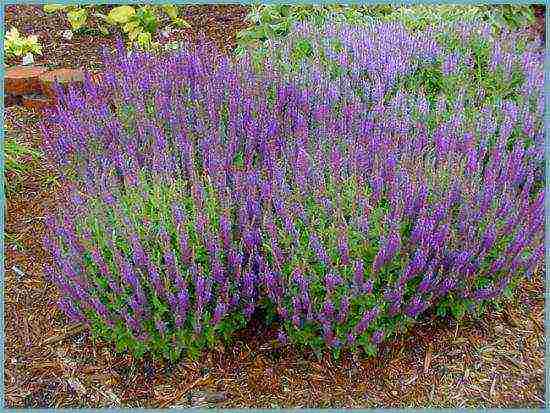
Sage is very thermophilic, so it needs to be covered well for the winter.
Since sage is a thermophilic plant, some perennial species are grown as one or two years in regions with harsh winters.
Important! Sage is a cross-pollinated plant, therefore, to preserve species characteristics, different varieties are planted at some distance.
Plant care
The plant is quite unpretentious - care consists in removing weeds and loosening the soil. For the winter, even the most frost-resistant species are covered with fallen leaves. In early spring, old shoots are cut, leaving about 10 cm from the root, the rosette is mulched with cut grass or peat. Watered very carefully, avoiding stagnant water. Often in the photo you can see such a landscape design technique as gravel mulching. This method is also acceptable for sage.
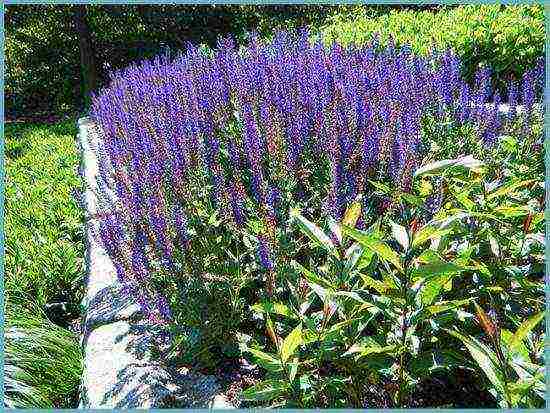
Mulch the soil, this will help the crop retain the necessary moisture
Fertilization and feeding
The correct development of sage is ensured by timely feeding:
- at the beginning of shoot formation, the plant perfectly accepts nitrogen fertilizers (for example, slurry in a ratio of 1: 10);
- during the period of bud formation - complex mineral fertilizers containing potassium and phosphorus (at the rate of 15-20 g per m2).
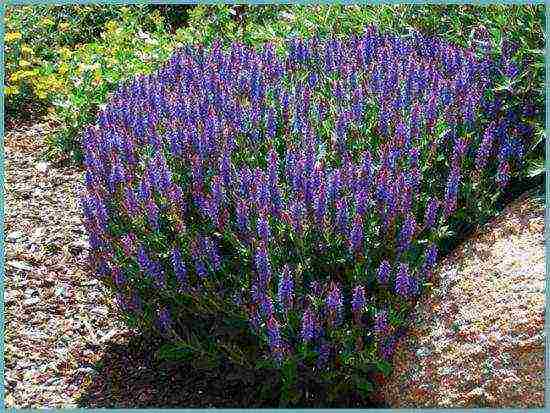
To feed sage you need mineral fertilizers
Fertilize the soil before planting the plant by introducing organic fertilizers (0.5-1 kg) in the wells in combination with mineral fertilizers (3-5 g).
Important! When planting sage, only rotted manure is used.
Reproduction of sage
Propagated in three ways:
- vegetatively - lignified cuttings;
- seeds and seedlings;
- dividing the bush or layering.
To obtain seedlings, seeds are sown in prepared containers in February-March. The first shoots appear in 1.5-2 weeks, and in the third week after planting, the seedlings dive into peat pots.In warm areas, already in April, seeds can be planted directly into open ground or used for winter planting. For spring sowing, the seeds are pre-soaked in a growth stimulator; in the fall, only dry seeds are embedded in the soil. The distance between the grooves is 15-20 cm, the depth is 4 cm.
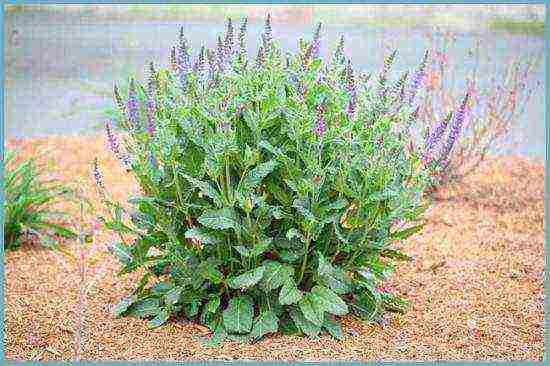
The easiest way to propagate sage is by cuttings.
Cuttings are carried out at any time. To do this, semi-lignified shoots are cut into 15 cm long pieces and rooted in a vessel with water. New roots appear within 2 weeks.
The pivotal root system of sage has the ability to form well-developed adventitious processes, so in late summer or early autumn, the bush can be planted painlessly.
Diseases and pests of sage
Since sage belongs to the group of herbal medicinal plants, in itself it is an excellent insecticide, resistant to diseases and pests. When over-watering, there is a danger of mildew (mold), so the soil around the plant should be slightly moist, but not waterlogged. Spraying with sulfur solution is a good remedy for mold. Pests rarely disturb the plant, but with thickened plantings, slugs, spider mites and thrips may appear.

Of the pests, sage is most often overcome by slugs.
Diseased plants are treated with tinctures of garlic, onion peels in combination with a solution of laundry soap.
Traditional methods of pest control
- Finely chop two heads of garlic, pour in a liter of water and leave for 5-7 days in a dark place. Dilute in a 1: 1 ratio with water, add 3-5 g of laundry soap, and spray the plants.
- For 100 g of onion husks steamed in 5 liters of water, take 10 g of soap, spray immediately after cooling.
Shrub sage: combination with other plants
Light airy spikelets of sage go well with large heads of noble flowers. The wide blue-violet palette creates a gorgeous backdrop for warm shades of reds, yellows and oranges.

Sage in a common flower bed
Examples:
- the combination of sage with chrysanthemums, roses, lilies is used in the design of classic gardens;
- bulbous - irises, daylilies, tulips, hyacinths in the company with sage will add charm to the alpine hills;
- for landscape design in a rustic style, varieties of oak sage in combination with cereals and herbs are irreplaceable.
Shrub sage in landscape design
One- or two-year-old hybrid varieties of sage, such as brilliant salvia or clary sage, are most often used in garden design. Nevertheless, perennials are often used to create mixborders, flower beds, flower beds.
A common use of perennial sage is to create a spice garden or aroma garden. A classic example of Salvia's neighbors on such an island:
- peppermint and apple mint;
- creeping thyme (thyme) and lemon;
- oregano and hyssop;
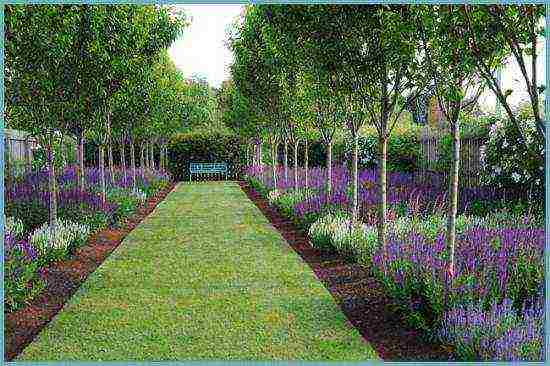
Sage in landscape design
- basil and rosemary;
- parsley and cucumber herb;
- chives and leeks.
Practical use of sage has earned him the fame of a garden healer. Essential oils and a varied composition of trace elements help in the treatment of lung diseases. In aromatherapy, sage is considered one of the most powerful sedatives. The plant is widely used in cooking as a spice. Growing perennial species in the garden guarantees health and good mood.
Sage cultivation and its benefits: video
Blooming sage: photo



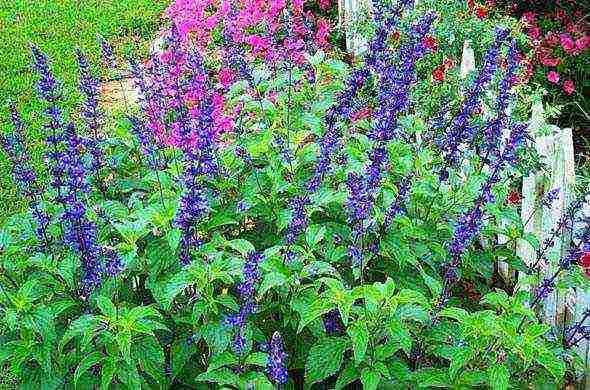
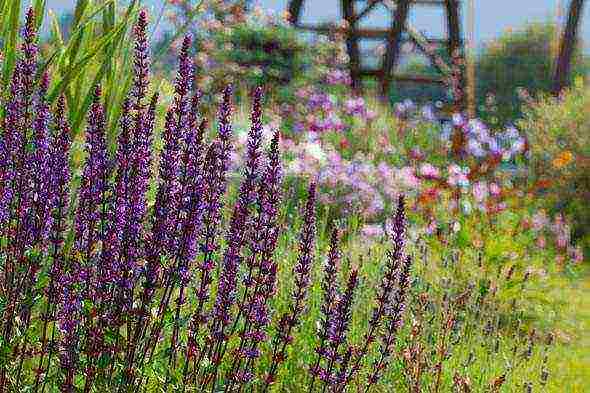
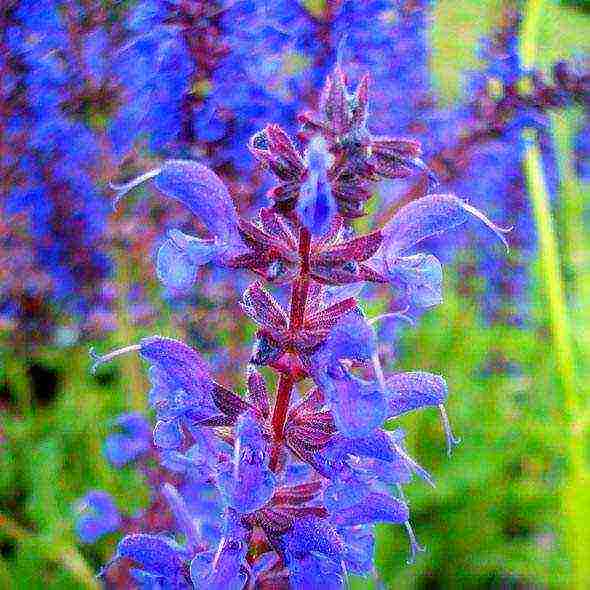
Sage, aka salvia, is another excellent representative of ornamental and medicinal plants. It belongs to the glorious genus of lamines, which gave rise to many beautiful and useful flowers. I love its beautiful, narrow foliage and blue flowers. After articles by one author about sage, I wanted to learn as much as possible about such a familiar and beautiful plant. It turned out that the shapes and colors of sage are different: from the usual to the most outlandish and extraordinary. There are 700 different sage species in the world.
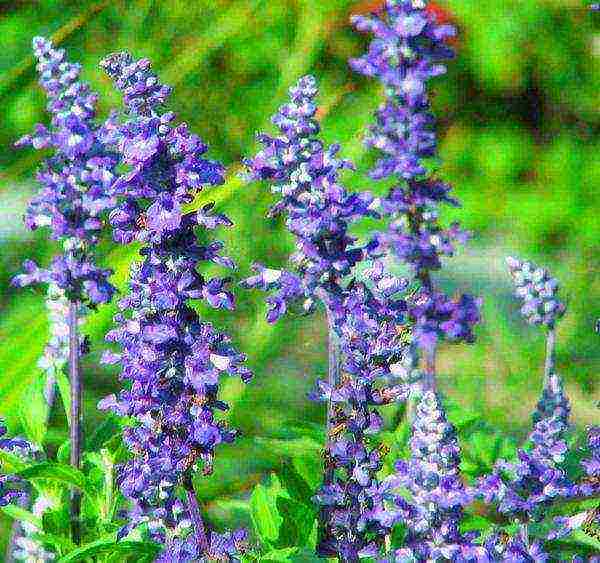
Sage is a perennial, but there are both annual and biennial species. Sage inflorescences are collected in panicles or spikelets. Stems are erect, can branch and reach a length of 120 cm.
Sage is an excellent helper in cooking and medicine. In ancient Rome, it was used in the treatment of many diseases, today it is just as relevant.
Planting sage
Most species of salvia officinalis like soils of normal acidity (5.5-6.5 pH). Plant sage in a well-lit area. It will grow better on light, fertile soils. Loamy soils are well suited for this.
To enrich the soil before planting sage, humus or compost, as well as phosphorus-potassium fertilizers, are introduced in the fall for digging. At the onset of spring, the soil is leveled and broken with a rake, after which nitrogen fertilizers are also introduced.
Sage has been growing in its place for over 8 years. This culture grows well, so the seedling method can not be used, but sow seeds directly into the ground in early spring (March - early April, using film) or in the fall under the snow. It does not matter if you are delayed with planting, you can sow in May, then a film shelter for seedlings is not needed. In this case, stratification and any other measures for germinating seeds are not required. You can arrange a ridge for sage, make a groove and seal the seeds to a depth of no more than 2 cm.Sage grows as a bush, so it is better to leave about 30 cm between the plants, and take about 50 cm between the rows.
It is not worth sowing sage after relatives from the lamb family. The precursors of sage can be potatoes, cabbage, onions, legumes.
Sage care
Pruning. In the second year after planting, like many spicy herbs with dense inflorescences, sage is renewed by cutting (10 cm from the soil surface).
Watering. Sage tolerates drought well, but it needs moisture to keep the greens juicy and tender. Otherwise, the leaves will simply become very tough. But it is not worth pouring, he does not like this.
Fertilization. In the spring before flowering, fertilizing with nitrogen mineral fertilizers is carried out, in the fall, after the plant is cut off and prepares for winter, many gardeners carry out fertilizing with phosphorus-potassium fertilizers in accordance with the norms on the package.
Sage harvest
It is customary to use and harvest sage during its flowering period. Leaves can be eaten fresh, or they can be harvested for the winter, in bunches or spread out in a dark, warm, ventilated place (in the attic).
Sage species
After the studies carried out by the Novosibirsk Research Station, 12 species resistant to steppe conditions were selected. But they turned out to be so different in their characteristics that they were divided into three groups:
1. Plants of American origin were identified in this group, their habitual environment is subtropics. In their natural environment, such plants live for several years. In the middle lane in winter, the plant dies, therefore it is cultivated as an annual. At least 100 days will pass from germination to flowering. Therefore, the sage of this group is grown mainly by seedlings.
2. This group already includes varieties of Mediterranean sage. In their natural environment, they are perennial, but in our middle lane in the open field they will die in winter, so they have to be grown as annual plants. But it will take about 40 days from germination to flowering. This suggests that you can do without seedlings.
3. The most popular group in our country. This group includes sage varieties that winter well in our open field. They are perennials in the temperate zone. This group also includes the Ethiopian sage, which is cultivated as a biennial. The most unaffected studies are Muscat, Marsh and Lavender Salvia.
I would also like to share with the reader photographs of different types of sage.
Salvia sticky
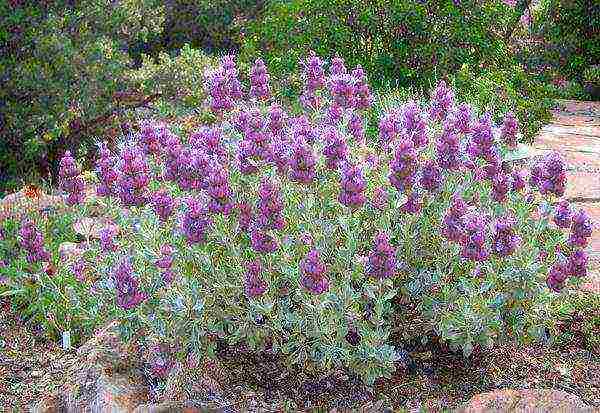
Salvia viridis
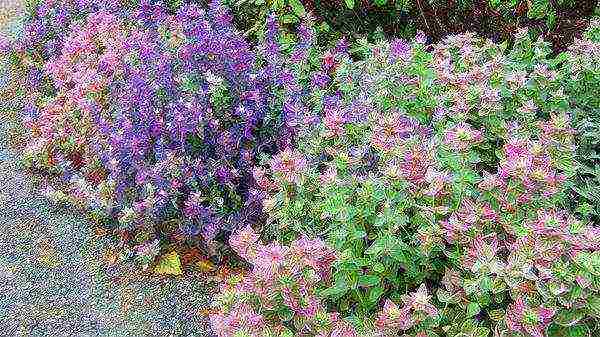
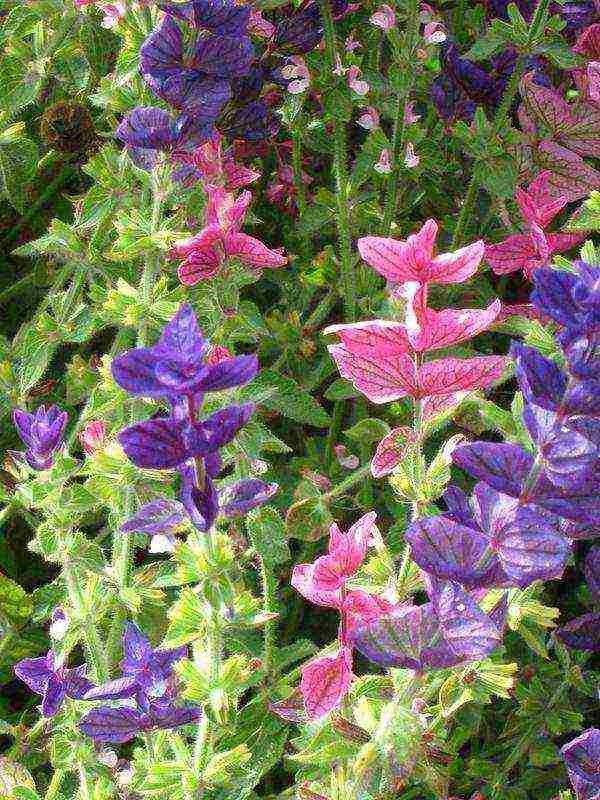
Salvia microphylla
Salvia dolomitica
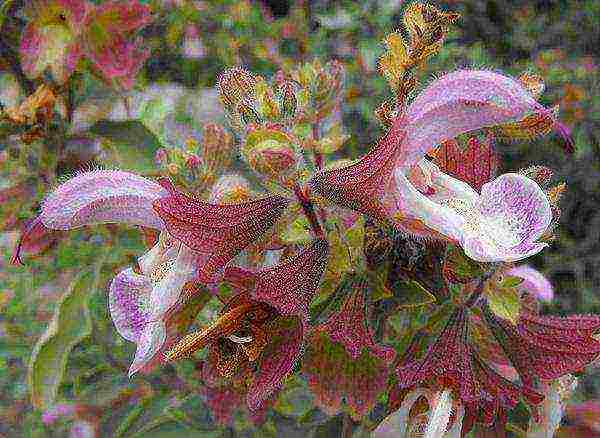
Sage varieties
Since this article mostly dealt with medicinal sage (vegetable), we will consider varieties that are suitable for different climatic zones and have excellent taste and irreplaceable medicinal properties.
Sage Breeze
This variety is included in the State Register of the Russian Federation, it is recommended for consumption fresh and dried (young shoots and foliage), it is used for the preparation of desserts, salads, soups, sauces, meat, fish. Plants of this variety reach about 60 cm in height, with erect shoots and dense foliage. The leaves are pubescent, toothed at the edges. In the second year after planting, the bush of the variety reaches about 280 g. Flowers are violet-blue in color. Seeds are small, brown-black in color.
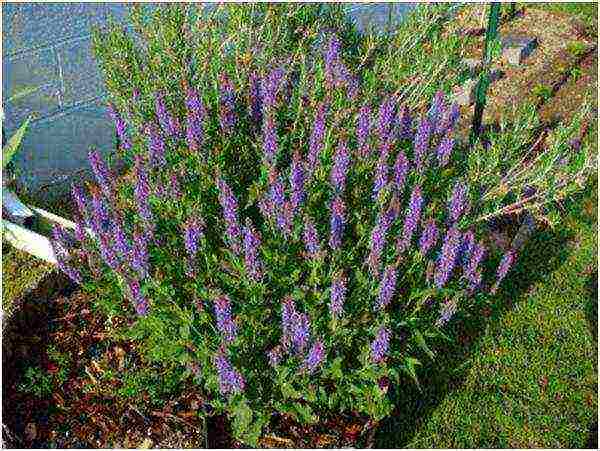
Sage Aibolit
Like the previous variety, it is included in the State Register of the Russian Federation. It is consumed both fresh and dry. The plant is larger than the previous one, 60-120 cm tall. The leaf is dark green, finely toothed along the edge, wrinkled, has strong pubescence. It is customary to use the variety in the second year after planting, after a month from the beginning of the growing season. But it is not as persistent in winter as the previous variety, so in the middle lane it is better to cover it for the winter.
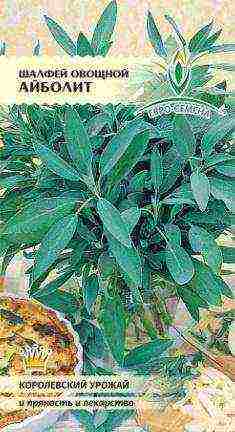
Sage Nectar
The variety, included in the State Register of the Russian Federation, is very popular when combined with cheese and in aromatic culinary compositions. Its height is about 100 cm, the stem is erect. Foliage color is light green with pubescence. The flowers are blue-violet.

Sage Patriarch Semko
The variety is used dry and fresh; it has been included in the State Register since 2000. The height of this variety is 50-80 cm. Erect, stiff stems at the bottom. Dense foliage up to 10 cm long. At the top of the shoot, the leaves are smaller. The seeds are in the form of a ball, the flowers are blue-violet.
I also recommend another author's excellent article on this wonderful plant.
